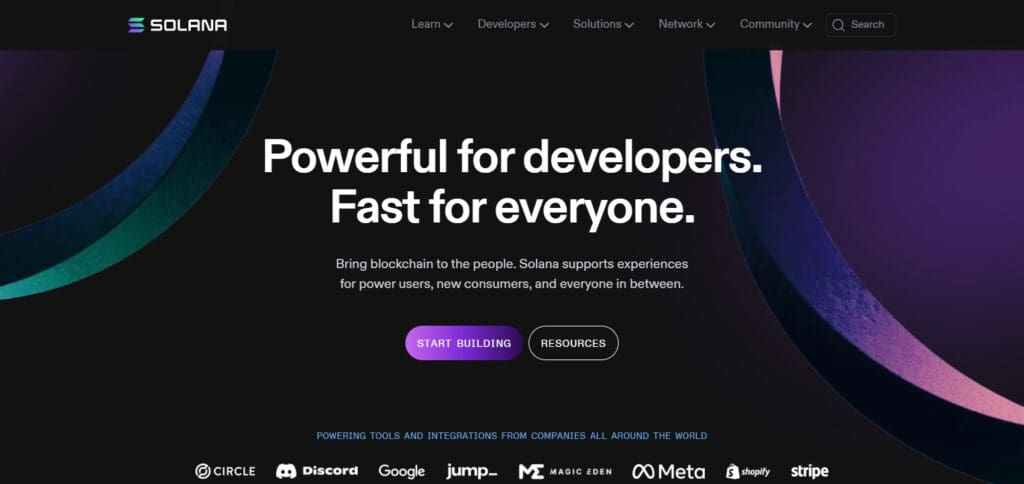This article analyzes Solana vs Polkadot vs Avalanche, the leading blockchain platforms in innovation, speed, and scaling.
Each platform has its strengths; for Solana, it’s the transaction speed, for Polkadot it is interoperability, and Avalanche excels at resisting congestion.
The comparison of their features and pros and cons will help you figure out which blockchain platform meets your requirements.
What Is Solana?
A blockchain that prioritizes speed, scale and decentralization, Solana was launched in 2020 by Solana Labs. Its innovative approach using Proof of Stake (PoS) in combo with Proof of History (PoH) allows it to process over 65,000 transactions a second for a fraction of a cent.

This solves the inefficiencies of early blockchain such as Ethereum. Additionally, Solana’s support for smart contracts allows decentralized applications in DeFi, gaming and NFTs.
Its native cryptocurrency, SOL, allows users to pay fees, participate in staking, and vote on governance decisions. It is evident that Solana offers an astonishingly efficient solution to blockchain technology.
What Is Polkadot?
Polkadot is an advanced blockchain system developed to facilitate the interoperability of different blockchains, enabling seamless communication and data sharing across multiple blockchains.
Polkadot was launched in 2020 by the Web3 Foundation and co-founded by Gavin Wood, an Ethereum co-creator. Polkadot comes with a central Relay Chain that coordinates several parallel blockchains, known as “parchain”.

This design improves scalability, multifaceted security, and customizability while serving a plethora of applications from DeFi to identity management portals.
DOT, its indigenous token, is utilized in governance, staking, and bonding of parachains, thus emerging as a major player in the decentralized interconnected Web3 ecosystem and its development.
What Is Avalanche?
Ava Labs launched Avalanche in 2020 as an open-source blockchain platform that enables quick, affordable transactions along with scalable decentralized applications.
With its special consensus algorithm, Avalanche can achieve near-instant finality while processing thousands of transactions in a second.

Avalanche’s architecture supports subnetworks, which consist of the Primary Network (subnetworks containing asset exchange, smart contracts, and validator coordination).
It is well-suited for custom networks and Ethereum compatible projects for DeFi and enterprise applications. AVAX is the platform’s token that covers transaction fees, allows staking, and partaking in governance which enables strong scalability.
Solana vs. Polkadot vs. Avalanche

Consensus Mechanism
- Solana employs Proof of History (PoH) fused with Proof of Stake (PoS) allowing rapid ordering of transactions.
- Polkadot uses Nominated Proof of Stake (NPoS) for the selection of validators and subsystem security.
- Avalanche utilizes a unique implementation of PoS that incorporates both classical and Nakamoto consensus enabling rapid finality.
Transaction Speed
- Solana supports up to 65,000 TPS with an emphasis on throughput.
- Polkadot’s transaction speed is capped at 1,000 TPS expandable with parachains.
- Avalanche supports 4,500 TPS with subnet scalability.
Finality Time
- For Solana finality time takes approximately 0.4 seconds.
- Polkadot takes considerably longer at ~12-60 seconds due to the need for cross chain coordination.
- Avalanche requires 1-2 seconds enabling rapid confirmation.
Architecture
- Solana has a single chain architecture design which allows speed and simplicity.
- With the architecture of Polkadot, the Relay Chain connects several parachains enabling interoperability.
- Avalanche employs multi-chain architecture (X, C, P) allowing customizable subnets.
Primary Focus
- Solana has a focus on high performance and low-cost transactions.
- For block chain interoperability, Polkadot is the answer.
- Avalanche utilizes the flexibility and support of multi-purpose blockchains.
Transaction Fees
- With Solana fees sit at roughly $0.001.
- Polkadot’s fees are moderate sitting between $0.01-$0.10.
- Avalanched sits slightly higher than Solana at $0.01.
Native Token:
- Solana charges fees and offers staking on the native token SOL.
- Polkadot uses the native token DOT for governance and bonding of parachains.
- Avalanche governs, charges fees, and offers staking on the native token AVAX.
Strengths
- Solana offers unparalleled speed and scalability.
- Polkadot supports seamless interoperability amongst blockchains.
- Avalanche comprises a versatile and developer-friendly ecosystem.
Weaknesses
- Solana suffers from centralization issues and network instability.
- The complexity of Polkadot’s design results in lower speeds.
- Avalanche has lower throughput than Solana, but higher fees.
How Does Solana Work?
Solana is a remarkably rapid blockchain network that employs a novel consensus technique named as “Proof of Stake Time” (PoST), or “Proof of history” for transaction validation and incorporation to the blockchain.
Picture it as a digital conveyor belt. In this scenario, transactions are the packages and the PoST algorithm functions as the conveyor belt operator.
The operator makes certain that each package has been adequately sealed and stamped prior to being set on the conveyor belt meant for transportation to its final location.
Moreover, the speed of the conveyor belt is remarkably high, enabling the processing of thousands of transactions every second. Such processing efficiency makes Solana suitable for decentralized applications that need swift and effective transactions.
How Does Cardano Work?
In systems based on Proof of Stake (PoS), validator nodes who are allowed to maintain the blockchain are determined by their stake in the cryptocurrency.
These nodes compete to earn cryptocurrency by creating and adding new blocks to the blockchain.
Ouroboros has a different method of block creation than other blockchains. Each validator node has a ‘slot’ assigned to them which enables them to create a block during their assigned time frame.
The node can create a block for the time slot assigned to them and earns a reward if they successfully create the block.
This enables Cardano to process many transactions quickly and at a low cost allowing for a wide variety of applications.
Ouroboros is also aimed to be secure and resistant to many forms of attacks so that the Cardano blockchain can be reliable and work with integrity.
How Does Polkadot Work?
Polkadot, which is anticipated to revolutionize the realm of blockchain, was created with a focus on innovation, distinct feature such as the ability to harness the powers of multiple blockchains simultaneously with efficient communication.
In addition, it also helps to address the issues of scalability. Its structure is based upon three important components, distinct features of Polkadot which are, parachains, parathreads and relay chain.
Parachains are dependent blockchains which are connected to Polkadot and consequently, enable exchange of information and other important functions like powering decentralized applications, financial platforms, etc. These governing and consensus mechanisms grant them the power of self-governance, which further enhances their autonomy.
Parathreads are like parachains but with a flexible on-demand model. These chains are very useful for projects which do not require constant access to blockchain. It makes them suited to be used with lower traffic or temporary applications.
The relay chain, which is the core of Polkadot secures the entire chain. It ensures validation of transactions, helping in seamless communication through jump chains, and parathread. This enables sustainable, decentralized and efficient blockchain Polkdots ecosystem.
Energy Usage
Solana: Works the best for eco-friendly users.
Cardano: Uses a medium level of energy because of the high market cap which causes network congestion.
Avalanche: Uses less energy than Polkadot and Cardano.
Polkadot: Uses lower energy than underline Cardano but uses more than Avalanche.
Price Predictions for Cardano, Polkadot, Solana & Avalanche
Forecasted predictions report that Cardano (ADA) will rise, having a maximum price of $0.8441 in 2023. The average price for the year is noted to be around $0.75366 and the lowest anticipated value is $0.66322.
Polkadot (DOT) is slated to peak at $19.83 in 2025 on the back of the market preceding the following halving. Average price for the year is also expected to be around $18.26 with a minimum prediction of $16.70 .
Significant institutional investment is forecasted to Solana (SOL) which is predicted to push the maximum price to $25.41. Average price is set to lower at $21.18 with the lowest projection set to $16.94.
With an upward trajectory, Avalanche (AVAX) is expected to have a high $37.84 in 2023 with the average forecasted price of $33.78, but in bearish trends the price could lower to $29.73.
The predictions above may vary from their estimates due to market conditions, but these are based on market shifts and algorithm estimate prices.
Solana vs Polkadot vs Avalanche: Which is Better “Ethereum Killer”?
| Feature | Winner |
|---|---|
| Security | All |
| Scalability | Solana |
| Transaction Speed | Solana |
| Network Congestion Resistance | Avalanche |
| Algorithm Efficiency | All |
| Energy Efficiency | Polkadot |
| Interoperability | Polkadot |
Features Solana vs. Polkadot vs. Avalanch
Solana (SOL)
Mechanism of Consensus: Proof of Stake (PoS) blended with Proof of History (PoH) – PoH enhances transaction timestamps.
Speed of Transaction: 65,000 transactions per second (TPS).
Time of Finality: ~0.4 seconds for quick confirmation.
Structure/Architecture: No sidechains and sharded single-layered blockchain.
Cost of Transaction: Extremely low – around $0.001 per transaction, USD.
Smart Contracts: Yes, but need to be written in Rust or C, not easily EVM-compatible.
Cost Efficiency: High throughput via parallel processing (Sea Level Runtime).
Feature that Makes it Stand Out: Tower BFT improves consensus through historical proof.
Native Token: SOL that can be used for governance, staking, and paying fees.
Projected Future Focus: DeFi and dApps that enable transactions with low costs but high efficiency.
Polkadot (DOT)
Nominative Proof of Stake (NPoS) requires nominators to nominate validators for security.
Cost of Transaction: ~ 0.01 USD – 0.10 USD per transaction, moderate.
Mechanism of Consensus Mountain: DOT are used for governance and staking.
Finality Time: Due to interoperability, around 12 to 60 seconds.
High Scalability: Tied to Relay Chain, allows for the processing of transactions in parallel.
Smart Contracts: Moonbeam parachain allows for EVM-compatible features.
Significant Trait: XCM as a messaging system for interoperability of blockchains.
Focus: Integration of numerous blockchains into a single web. Avalanche (AVAX)
Consensus Mechanism: Innovative PoS system that combines the classical and Nakamoto PoS for efficiency and security.
Transaction Speed: More than 4,500 transactions per second possible, increases with use of subnets.
Finality Time: Reliable and rapid, around 1 – 2 seconds.
Architecture: Multi-chain- X-Chain (assets), C-Chain (smart contracts), P-Chain (validators)+subnets.
Transaction Cost: Approximately 10 cents, very economical.
Scalability: Open subnets enable partially autonomous, scalable networks.
Smart Contracts: Framed, uses Ethereum instruments in EVM compatible C-Chain.
Native Token: AVAX, serves as a means for paying fees, staking, and governance of subnets.
Unique Feature: Blockchains with unique and customized set of rules known as subnets.
Focus: Purpose built for decentralized applications and other platforms requiring high speed and flexibility.
Pros & Cons Of Solana vs. Polkadot vs. Avalanche
Solana (SOL)
Pros
High Throughput. Processing over 65,000 transactions (TPS) per second makes it among the fastest blockchain technologies.
Low Fees. Transaction fees are almost nonexistent (~$0.001), which is favorable for DeFi, NFTs, and microtransactions.
Growing Ecosystem. Adoption in DeFi, like Serum, and Meme coin platforms such as Pump.fun.
Fast Finality. Users experience transactions confirming in ~0.4 seconds.
Cons
Network Instability. Solana has suffered outages such as in 2021 and 2022.
Centralization Risk. Requirement for high performing hardware for a validator adds risk of higher decentralization compared to peers.
Competition. New challenges emerging from Ethereum Layer-2 solutions and other high-speed chains.
Polkadot (DOT)
Pros
Interoperability. Connecting multiple blockchains through its Relay Chain and cross-chain communication via its Parachains adds value.
Scalability. The base of ~1,000 TPS can be expanded with parallel processing due to the Parachain model.
Governance. Robust on-chain governance sets control in significant upgrades into the hands of DOT holders.
Security. Shared security model ensures the parachains inherit the robustness of the Relay Chain.
Cons:
Slower Transactions. Lagging due to finality taking ~12-60 seconds to Solana and Avalanche.
Complexity. Smaller projects and developers can be deterred by the technical setups and parachain auctions.
Moderate Fees. Microtransactions are more difficult due to cost (~0.01-0.10 USD), making these less competitive than Solana.
Avalanche (AVAX)
Pros:
Versatility – Very many use cases in DeFi, enterprises, etc are achieved due to the multi-chain architecture (X-Chain, C-Chain, P-Chain) and subnets.
Fast Finality – Reliability and speed is well balanced since transactions settle within 1-2 seconds.
High Scalability – It offers up to 4,500 TPS and further scaling is offered by subnets.
Ethereum Compatibility – Helps in migration of developers from Ethereum since C-Chain supports EVM.
Cons
Higher Fees – Costs ($0.01) are optimal for most, however, they are not optimal for as many applications as Solana’s.
Complexity – Creation of subnets require an adequate level of technical know-how and AVAX staking making them less accessible.
Market Competition – Having to compete against the speed of Solana and the flexibility of Polkadot makes it more difficult to create a separating niche.










